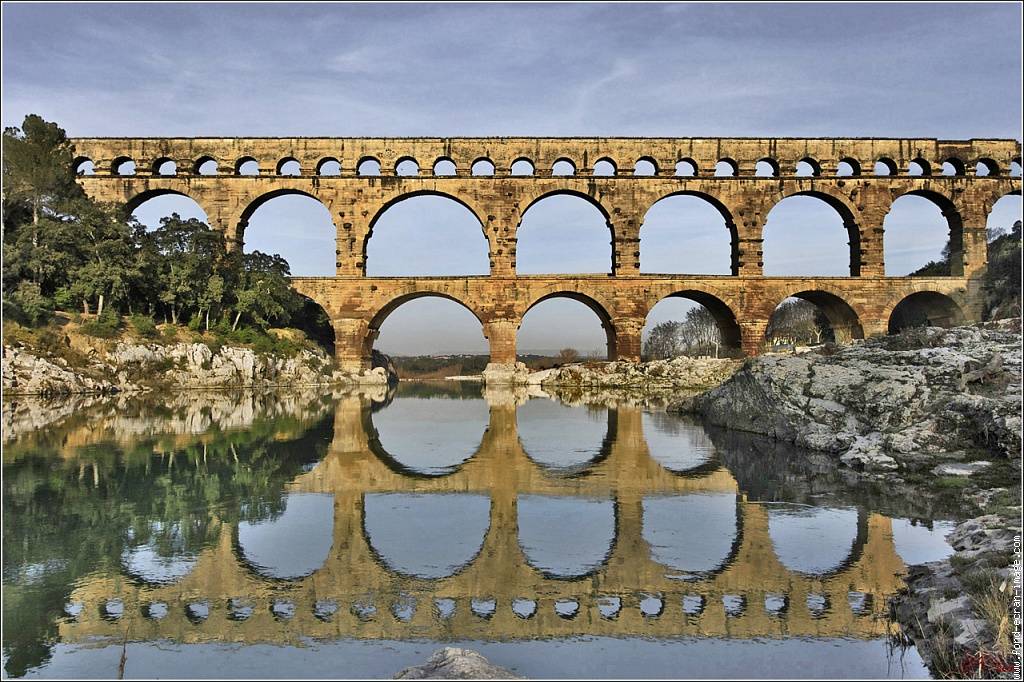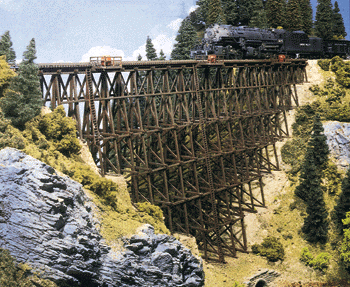Read the text about different building materials. Compare them and say which one is more suitable for permanent or temporary structures
Early bridges were made of timber and stone because those building materials were easily available from anywhere (fig. 6.1 – 6.4). Wood and rock were handy and abundant, and, besides, there were low labour costs since unskilled natives, slaves or soldiers did the work.
Many wooden and masonry bridges were built by the Romans. Using the circular arch form for masonry structures, they built much longer spans and provided more durability in comparison with wood. As stone is strong in compression, its primary application has been in arches, piers, and abutments. Besides, stone is durable, weatherproof and resistant to freezing and thawing. The most suitable rock for bridges is granite, basalt, dolomite as well as the widespread and rather cheap sandstone or limestone.

Figure 6.1 Masonry Bridge (каменный мост)

Figure 6.2 Timber Bridge (деревянный мост):
1 – Pile (свая); 2 – Stringer (прогон); 3 – Cap (насадка); 4 Post (стойка);
5 – Diagonal Braces (диагональные схватки); 6 – Log (бревно);
7 – Squared Beam (брус).
The bridge builders also used artificial stone, i.e. concrete made from a mixture of water, sand, gravel, and a binder, such as cement. It is strong in compression and rather weak in tension like natural rock. Bridge builders use concrete with embedded steel bars, called reinforced concrete, molding it into a variety of shapes and expressing their creative ideas by this artificial stone. The structures made of reinforced concrete are safe and durable because steel bars carry all the tension and concrete protects steel bars from corrosion and fire. Reinforced concrete has become an economical substitute for natural stone.
The Romans already knew cement and used it for constructing piers in rivers. They developed special technologies to pour concrete into the water within a ring of wooden piles driven into the riverbed. The Romans often sealed the ring with clay; therefore, they invented a cofferdam. Many Roman bridges have survived because they stand on cofferdam foundations, like for instance, the Pont Sant’Angelo Bridge, the finest surviving bridge in Rome, built across the Tiber River over 1,800 years ago. The bridge has seven stone arches and five main spans about 18 m each, supported on seven-meter piers. In the Middle Ages the bridge parapets were decorated with the statues of Saints Peter and Paul and ten statues of angels (fig.6.1a).

| 
|
| a – the Pont Sant’Angelo Bridge in Rome, Italy | b – The Pont du Gard Aqueduct Bridge, France |
Figure 6.3 Masonry Bridges
Masonry bridges offer the following advantages: long-lasting performance (only wars and earthquakes can destroy them); the aesthetic merits of masonry bridges blend well with many different urban landscapes; larger ability to resist overloads; considerable reduction of maintenance costs. Possible disadvantages of masonry bridges are: higher dead weight as stone density is between 2 and 2.7 t/m³; only the arch structure is allowed, and it requires solid ground and powerful foundations to rest on (fig. 6.1; 6.2); construction of masonry bridges requires a lot of manual labour.
Wood is relatively weak in both compression and tension, but it has usually been widely available and inexpensive. It suits well for small footbridges. Engineers now incorporate laminated wooden beams and arches into some modern bridges (fig. 3.1a; 6.4).

| 
|
| a – Railway timber bridge | b – Covered timber bridge |
Figure 6.4 Timber Bridges
Timber bridges usually serve as short-term structures lasting only for 10-15 years. Bridge foundations are often made of timber piles and cribs (fig. 6.1). The best types of softwood used for spans and piers are pine, spruce, fir, larch and cedar. This well structured wood is good for woodworking and does not rapidly decay. The most important elements – the caps and dowels are made of most expensive wood species such as oak, hornbeam and beech. To increase its water resistant capability, builders impregnate timber with antiseptics. It extends the service life up to 25-30 years. Plywood spans are widely used because they are more durable, rigid and lighter than those made of logs and squared beams.